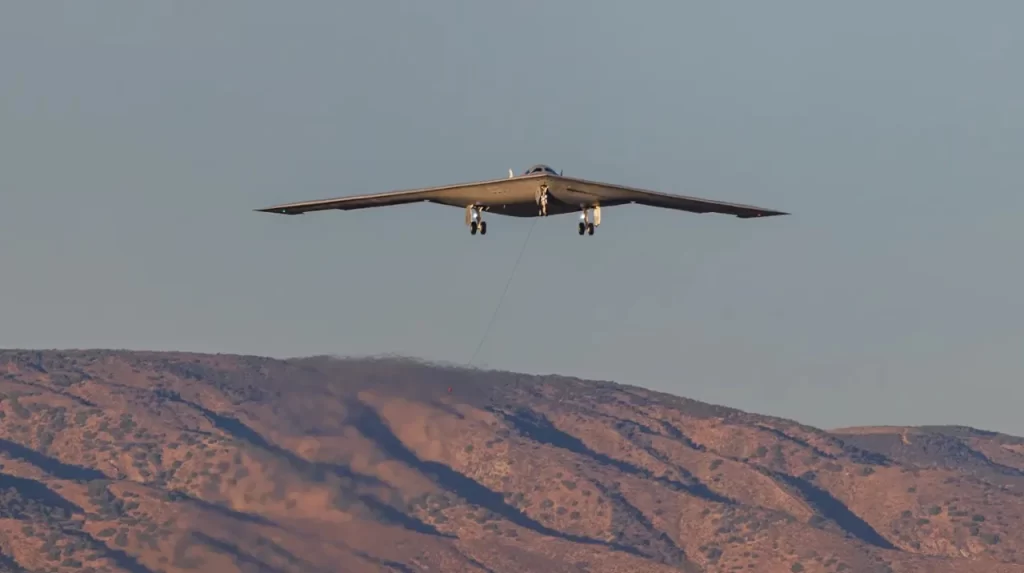The United States Air Force (USAF) plans to acquire “only” 100 B-21 Raider strategic bombers, a number that critics consider very low.
General David Allvin, the Chief of Staff of the United States Air Force, defended the purchase of 100 B-21 bombers before the Senate Armed Services Committee.
The B-21 represents the future of the American bomber fleet. However, the production of 100 aircraft will extend into the second half of the 2030s. As General David Allvin stated, newer technologies may emerge at that time, so the Air Force is considering the prospect of purchasing additional B-21s. The technology may be able to increase the number and provide a better mix of bombing capabilities in the future.
Allvin did not specify what other technologies the Air Force is considering after the B-21 to “enhance” its capabilities.
However, the B-21 is supposed to be part of a “family of systems,” and collaboration between the B-21 and unmanned aircraft has been planned from the beginning. Therefore, the USAF is undoubtedly considering introducing an unmanned bomber after 2035.
Another future aspect may be its engine. The new American bomber mainly uses proven and commercially available technologies, including the engines, to accelerate development and production.
The B-21, with an estimated wingspan of 41.5 meters, is set to be powered by a pair of Pratt & Whitney PW9000 engines based on the core of the commercial PW1000G engine. In 2010, Pratt & Whitney proposed this engine for military aircraft, including bombers. Based on this information and other indicators, such as the shape of the aircraft’s engine inlets, the portal Aviation Week identifies the PW9000 as the likely propulsion unit for the B-21.
However, several programs are developing future high-thrust, low-fuel-consumption jet engines that offer extended ranges.
This aligns with the Air Force’s plan—or the plan of all United States Armed Forces branches—to be much more agile and flexible in adopting new technologies.
The technologies implemented on the B-21 are approximately ten to fifteen years old. In the near future, it is not implausible that more recent concepts might take control of certain B-21 missions, potentially entailing a paradigm shift in air combat operations. Increasing the USAF’s flexibility and avoiding protracted development and production cycles are currently critical from a strategic standpoint.
Nevertheless, the B-21 is a reality – the future of the USAF for conventional and nuclear strikes. Even though their production may end as early as 2035, they will remain in service until at least 2060 and beyond. The B-21 is almost on the original schedule and budget and provides capabilities. Currently, the bomber is in the testing phase. General David Allvin says, “We have just received Milestone C approval to enter Low-Rate Initial Production.”

The USA will require two billion dollars less for the B-21 program in the next two fiscal years than previous plans. In the budget request for FY2025, the Air Force is asking for 2.7 billion dollars to purchase an unspecified number of B-21s, down from the previous estimate of four billion dollars. Similarly, for FY2026, the request has been reduced by approximately 600 million dollars to 3.9 billion dollars.
This signifies a reduction in the price per unit of the B-21. At the same time, ongoing efforts are devoted to research, development, testing, and evaluation (RDT&E) of new technologies and concepts. Long-term experiments, evaluation of diverse alternatives and concepts, analysis of outcomes, and revision of technical specifications may be conducted throughout this phase. For specific programs, RDT&E can last for years or even decades. For instance, RDT&E is still being conducted on the F-35.
Nearly three billion dollars will be allocated to RDT&E for the B-21 during the current fiscal year; by FY2025, that amount will have decreased to 2.6 billion dollars.
At the end of 2023, the B-21 program achieved Milestone C, signifying the culmination of the Engineering & Manufacturing Development (EMD) phase in November 2023 after a single test flight. EMD refers to the Pentagon’s acquisition strategy phase, during which prototypes of new weapon systems are manufactured, designed, and developed.
The USAF has acknowledged only one additional test flight, although there likely have been more. Northrop representatives have stated that high-frequency test flights would follow the first flight.
The most significant information is the confirmation of building “only” ten B-21s per year, aligning with previous estimates. The Pentagon’s acquisition and sustainment chief, William LaPlante, recently said that deliberately low production rates protect the B-21 program from budget cuts. “Many painful lessons from the F-35 have been applied to the B-21,” said LaPlante.
At the same time, General Anthony J. Cotton, the head of the United States Strategic Command, told Republican Senator Tom Cotton in February that the limited rate of B-21 production is the only thing he wishes could be a little faster.
“It would be nice to have more than 100,” Senator Cotton responded. “Yes, sir,” replied General Cotton.
The original requirement from 2015 was for 80 to 100 B-21s, and in recent years, the requirement has been raised to at least 100. Various think tanks have called for 225 to 250 B-21s. However, the USAF insists on 100 B-21s.
As the B-21 is gradually introduced, the Air Force will begin retiring the B-1B Lancer and B-2A Spirit bombers. By the mid-2030s, the Air Force arsenal will consist of only two types of bombers – 100 B-21 Raiders and 75 re-engined and significantly upgraded B-52J Stratofortress. However, this won’t be enough. General Thomas A. Bussiere, the head of Air Force Global Strike Command, said in March 2023 that a fleet of 220 bombers is the minimum requirement.
